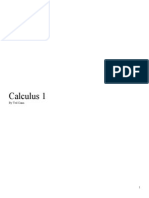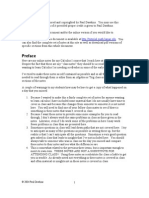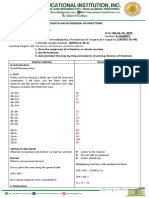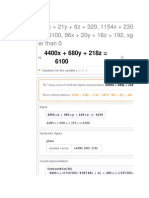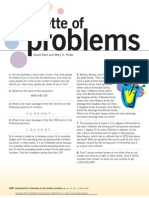Preface: Calculus II
Preface: Calculus II
Uploaded by
Rishabh SinghCopyright:
Available Formats
Preface: Calculus II
Preface: Calculus II
Uploaded by
Rishabh SinghOriginal Title
Copyright
Available Formats
Share this document
Did you find this document useful?
Is this content inappropriate?
Copyright:
Available Formats
Preface: Calculus II
Preface: Calculus II
Uploaded by
Rishabh SinghCopyright:
Available Formats
Calculus II
Preface
Here are my online notes for my Calculus II course that I teach here at Lamar University.
Despite the fact that these are my class notes, they should be accessible to anyone wanting to
learn Calculus II or needing a refresher in some of the topics from the class.
These notes do assume that the reader has a good working knowledge of Calculus I topics
including limits, derivatives and basic integration and integration by substitution.
Calculus II tends to be a very difficult course for many students. There are many reasons for this.
The first reason is that this course does require that you have a very good working knowledge of
Calculus I. The Calculus I portion of many of the problems tends to be skipped and left to the
student to verify or fill in the details. If you dont have good Calculus I skills, and you are
constantly getting stuck on the Calculus I portion of the problem, you will find this course very
difficult to complete.
The second, and probably larger, reason many students have difficulty with Calculus II is that you
will be asked to truly think in this class. That is not meant to insult anyone; it is simply an
acknowledgment that you cant just memorize a bunch of formulas and expect to pass the course
as you can do in many math classes. There are formulas in this class that you will need to know,
but they tend to be fairly general. You will need to understand them, how they work, and more
importantly whether they can be used or not. As an example, the first topic we will look at is
Integration by Parts. The integration by parts formula is very easy to remember. However, just
because youve got it memorized doesnt mean that you can use it. Youll need to be able to look
at an integral and realize that integration by parts can be used (which isnt always obvious) and
then decide which portions of the integral correspond to the parts in the formula (again, not
always obvious).
Finally, many of the problems in this course will have multiple solution techniques and so youll
need to be able to identify all the possible techniques and then decide which will be the easiest
technique to use.
So, with all that out of the way let me also get a couple of warnings out of the way to my students
who may be here to get a copy of what happened on a day that you missed.
1. Because I wanted to make this a fairly complete set of notes for anyone wanting to learn
calculus I have included some material that I do not usually have time to cover in class
and because this changes from semester to semester it is not noted here. You will need to
find one of your fellow class mates to see if there is something in these notes that wasnt
covered in class.
2. In general I try to work problems in class that are different from my notes. However,
with Calculus II many of the problems are difficult to make up on the spur of the moment
and so in this class my class work will follow these notes fairly close as far as worked
problems go. With that being said I will, on occasion, work problems off the top of my
head when I can to provide more examples than just those in my notes. Also, I often
2007 Paul Dawkins i http://tutorial.math.lamar.edu/terms.aspx
Calculus II
dont have time in class to work all of the problems in the notes and so you will find that
some sections contain problems that werent worked in class due to time restrictions.
3. Sometimes questions in class will lead down paths that are not covered here. I try to
anticipate as many of the questions as possible in writing these up, but the reality is that I
cant anticipate all the questions. Sometimes a very good question gets asked in class
that leads to insights that Ive not included here. You should always talk to someone who
was in class on the day you missed and compare these notes to their notes and see what
the differences are.
4. This is somewhat related to the previous three items, but is important enough to merit its
own item. THESE NOTES ARE NOT A SUBSTITUTE FOR ATTENDING CLASS!!
Using these notes as a substitute for class is liable to get you in trouble. As already noted
not everything in these notes is covered in class and often material or insights not in these
notes is covered in class.
2007 Paul Dawkins ii http://tutorial.math.lamar.edu/terms.aspx
Calculus II
Ratio Test
In this section we are going to take a look at a test that we can use to see if a series is absolutely
convergent or not. Recall that if a series is absolutely convergent then we will also know that its
convergent and so we will often use it to simply determine the convergence of a series.
Before proceeding with the test lets do a quick reminder of factorials. This test will be
particularly useful for series that contain factorials (and we will see some in the applications) so
lets make sure we can deal with them before we run into them in an example.
If n is an integer such that n 0 then n factorial is defined as,
n ! = n ( n 1)( n 2 ) ( 3)( 2 )(1) if n 1
0! = 1 by definition
Lets compute a couple real quick.
1! = 1
= (1) 2
2! 2=
= ( 2 )(1) 6
3! 3=
= ( 3)( 2 )(1) 24
4! 4=
= ( 4 )( 3)( 2 )(1) 120
5! 5=
In the last computation above, notice that we could rewrite the factorial in a couple of different
ways. For instance,
5!= 5 ( 4 )( 3)( 2 )(1)= 5 4!
4!
5! 5 ( 4 )( 3)( 2 )(
= = 1) 5 ( 4 ) 3!
3!
In general we can always strip out terms from a factorial as follows.
n != n ( n 1)( n 2 ) ( n k ) ( n ( k + 1) ) ( 3)( 2 )(1)
= n ( n 1)( n 2 ) ( n k ) ( n ( k + 1) ) !
= n ( n 1)( n 2 ) ( n k ) ( n k 1) !
We will need to do this on occasion so dont forget about it.
Also, when dealing with factorials we need to be very careful with parenthesis. For instance,
( 2n )! 2 n ! as we can see if we write each of the following factorials out.
( 2n )=! ( 2n )( 2n 1)( 2n 2 ) ( 3)( 2 )(1)
2= n ! 2 ( n )( n 1)( n 2 ) ( 3)( 2 )(1)
2007 Paul Dawkins 3 http://tutorial.math.lamar.edu/terms.aspx
Calculus II
Again, we will run across factorials with parenthesis so dont drop them. This is often one of the
more common mistakes that students make when they first run across factorials.
Okay, we are now ready for the test.
Ratio Test
Suppose we have the series a n . Define,
an +1
L = lim
n an
Then,
1. if L < 1 the series is absolutely convergent (and hence convergent).
2. if L > 1 the series is divergent.
3. if L = 1 the series may be divergent, conditionally convergent, or absolutely convergent.
A proof of this test is at the end of the section.
Notice that in the case of L = 1 the ratio test is pretty much worthless and we would need to
resort to a different test to determine the convergence of the series.
Also, the absolute value bars in the definition of L are absolutely required. If they are not there it
will be impossible for us to get the incorrect answer.
Lets take a look at some examples.
Example 1 Determine if the following series is convergent or divergent.
( 10 )
n
n =1 4
2 n +1
( n + 1)
Solution
With this first example lets be a little careful and make sure that we have everything down
correctly. Here are the series terms an.
( 10 )
n
an = 2 n +1
4 ( n + 1)
Recall that to compute an+1 all that we need to do is substitute n+1 for all the ns in an.
( 10 ) ( 10 )
n +1 n +1
=an +1 =
4 2( n +1) +1
( ( n + 1) + 1) 4 ( n + 2)
2 n +3
Now, to define L we will use,
1
=L lim an +1
n an
since this will be a little easier when dealing with fractions as weve got here. So,
2007 Paul Dawkins 4 http://tutorial.math.lamar.edu/terms.aspx
Calculus II
( 10 ) 42 n +1 ( n + 1)
n +1
L = lim
n 42 n +3 ( n + 2 ) ( 10 )n
10 ( n + 1)
= lim
n 42 ( n + 2 )
10 n +1
= lim
16 n n+2
10
= <1
16
So, L < 1 and so by the Ratio Test the series converges absolutely and hence will converge.
As seen in the previous example there is usually a lot of canceling that will happen in these.
Make sure that you do this canceling. If you dont do this kind of canceling it can make the limit
fairly difficult.
Example 2 Determine if the following series is convergent or divergent.
n!
n =0 5
n
Solution
Now that weve worked one in detail we wont go into quite the detail with the rest of these.
Here is the limit.
= =
L lim
( n + 1)! 5n lim ( n + 1)!
n 5n +1 n ! n 5 n !
In order to do this limit we will need to eliminate the factorials. We simply cant do the limit
with the factorials in it. To eliminate the factorials we will recall from our discussion on
factorials above that we can always strip out terms from a factorial. If we do that with the
numerator (in this case because its the larger of the two) we get,
L = lim
( n + 1) n !
n 5 n!
at which point we can cancel the n! for the numerator an denominator to get,
L = lim
( n + 1) = > 1
n 5
So, by the Ratio Test this series diverges.
Example 3 Determine if the following series is convergent or divergent.
n2
n = 2 ( 2n 1) !
Solution
In this case be careful in dealing with the factorials.
2007 Paul Dawkins 5 http://tutorial.math.lamar.edu/terms.aspx
Calculus II
( n + 1) ( 2n 1)!
2
L = lim
( ) n2
n 2 ( n + 1) 1 !
( n + 1) ( 2n 1)!
2
= lim
n ( 2n + 1) ! n2
( n + 1) ( 2n 1)!
2
= lim
n ( 2n + 1)( 2n )( 2n 1) ! n2
( n + 1)
2
= lim
(
n 2n + 1 2n
)( ) ( n2 )
= 0 <1
So, by the Ratio Test this series converges absolutely and so converges.
Example 4 Determine if the following series is convergent or divergent.
9n
( 2 )
n +1
n =1 n
Solution
Do not mistake this for a geometric series. The n in the denominator means that this isnt a
geometric series. So, lets compute the limit.
( 2 )
n +1
9n +1 n
L = lim
( 2 ) ( n + 1)
n n+2 n
9
9n
= lim
n ( 2 )( n + 1)
9 n
= lim
2 n n +1
9
= >1
2
Therefore, by the Ratio Test this series is divergent.
In the previous example the absolute value bars were required to get the correct answer. If we
hadnt used them we would have gotten L = 92 < 1 which would have implied a convergent
series!
Now, lets take a look at a couple of examples to see what happens when we get L = 1 . Recall
that the ratio test will not tell us anything about the convergence of these series. In both of these
examples we will first verify that we get L = 1 and then use other tests to determine the
convergence.
2007 Paul Dawkins 6 http://tutorial.math.lamar.edu/terms.aspx
Calculus II
Example 5 Determine if the following series is convergent or divergent.
( 1)
n
n
n =0
2
+1
Solution
Lets first get L.
1)
( =
n +1
n2 + 1 n2 + 1
=L lim =
lim 1
( n + 1) + 1 ( 1) ( n + 1) + 1
n 2 n n 2
So, as implied earlier we get L = 1 which means the ratio test is no good for determining the
convergence of this series. We will need to resort to another test for this series. This series is an
alternating series and so lets check the two conditions from that test.
1
= lim bn lim= 0
n n n + 1
2
1 1
bn = > = bn +1
n + 1 ( n + 1)2 + 1
2
The two conditions are met and so by the Alternating Series Test this series is convergent. Well
leave it to you to verify this series is also absolutely convergent.
Example 6 Determine if the following series is convergent or divergent.
n+2
n = 0 2n + 7
Solution
Heres the limit.
=L lim = lim
n+3 2n + 7
= 1
( n + 3)( 2n + 7 )
n 2 ( n + 1) + 7 n + 2 n ( 2n + 9 )( n + 2 )
Again, the ratio test tells us nothing here. We can however, quickly use the divergence test on
this. In fact that probably should have been our first choice on this one anyway.
n+2 1
lim = 0
n 2n + 7 2
By the Divergence Test this series is divergent.
So, as we saw in the previous two examples if we get L = 1 from the ratio test the series can be
either convergent or divergent.
There is one more thing that we should note about the ratio test before we move onto the next
section. The last series was a polynomial divided by a polynomial and we saw that we got L = 1
from the ratio test. This will always happen with rational expression involving only polynomials
or polynomials under radicals. So, in the future it isnt even worth it to try the ratio test on these
kinds of problems since we now know that we will get L = 1 .
2007 Paul Dawkins 7 http://tutorial.math.lamar.edu/terms.aspx
Calculus II
Also, in the second to last example we saw an example of an alternating series in which the
positive term was a rational expression involving polynomials and again we will always get
L = 1 in these cases.
Lets close the section out with a proof of the Ratio Test.
Proof of Ratio Test
First note that we can assume without loss of generality that the series will start at n = 1 as weve
done for all our series test proofs.
Lets start off the proof here by assuming that L < 1 and well need to show that a n is
absolutely convergent. To do this lets first note that because L < 1 there is some number r such
that L < r < 1 .
Now, recall that,
an +1
L = lim
n an
and because we also have chosen r such that L < r there is some N such that if n N we will
have,
an +1
<r an +1 < r an
an
Next, consider the following,
aN +1 < r aN
aN + 2 < r aN +1 < r 2 aN
aN +3 < r aN + 2 < r 3 aN
aN + k < r aN + k 1 < r k aN
So, for k = 1, 2,3, we have aN + k < r k aN . Just why is this important? Well we can now
look at the following series.
a
k =0
N rk
This is a geometric series and because 0 < r < 1 we in fact know that it is a convergent series.
Also because aN + k < r k aN by the Comparison test the series
n=
N +1
an = aN + k
k=
1
is convergent. However since,
N
=
a a
n= 1
n
n= 1
n +
n= N +1
an
2007 Paul Dawkins 8 http://tutorial.math.lamar.edu/terms.aspx
Calculus II
we know that a
n =1
n is also convergent since the first term on the right is a finite sum of finite
terms and hence finite. Therefore a
n =1
n is absolutely convergent.
Next, we need to assume that L > 1 and well need to show that a n is divergent. Recalling
that,
an +1
L = lim
n an
and because L > 1 we know that there must be some N such that if n N we will have,
an +1
>1 an +1 > an
an
However, if an +1 > an for all n N then we know that,
lim an 0
n
because the terms are getting larger and guaranteed to not be negative. This in turn means that,
lim an 0
n
Therefore, by the Divergence Test a n is divergent.
Finally, we need to assume that L = 1 and show that we could get a series that has any of the
three possibilities. To do this we just need a series for each case. Well leave the details of
checking to you but all three of the following series have L = 1 and each one exhibits one of the
possibilities.
1
n
n =1
2
absolutely convergent
( 1)
n
n =1 n
conditionally convergent
1
n
n =1
divergent
2007 Paul Dawkins 9 http://tutorial.math.lamar.edu/terms.aspx
You might also like
- AMC 12 Study Guide PDFDocument17 pagesAMC 12 Study Guide PDFHarsha Polavaram100% (1)
- T Koshy Elementary Number Theory With Applications Solutions PDFDocument204 pagesT Koshy Elementary Number Theory With Applications Solutions PDFrahayu rizki putri100% (1)
- Calculus - Differentiation 2Document72 pagesCalculus - Differentiation 2Amina Rakha HassanNo ratings yet
- v2 - Algebra II (Common Core) Regents Review Sheet - Facts You Must Know ColdDocument19 pagesv2 - Algebra II (Common Core) Regents Review Sheet - Facts You Must Know ColdIkhri574100% (1)
- Course Notes - Calculus 1Document34 pagesCourse Notes - Calculus 1Amirah SyahirahNo ratings yet
- Mth301 Quiz FileDocument46 pagesMth301 Quiz FileSadia Mirza100% (2)
- 2-2 Practice: Linear Relations and FunctionsDocument1 page2-2 Practice: Linear Relations and FunctionsCatalinaNo ratings yet
- Preface: Calculus IIDocument9 pagesPreface: Calculus IIduckoduckNo ratings yet
- CalcII ImproperIntegrals PDFDocument9 pagesCalcII ImproperIntegrals PDFmikeraulNo ratings yet
- Calculus - Improper IntegralsDocument9 pagesCalculus - Improper IntegralsNapoleon Son PoloNo ratings yet
- De RealEigenvaluesDocument12 pagesDe RealEigenvaluesSangramjit SarkarNo ratings yet
- De RepeatedEigenvaluesDocument9 pagesDe RepeatedEigenvaluesSangramjit SarkarNo ratings yet
- DE Second Order Concepts PDFDocument7 pagesDE Second Order Concepts PDFmalini72No ratings yet
- TextDocument34 pagesTextrohitkyadav0999No ratings yet
- Differential Equations Variation of ParametersDocument8 pagesDifferential Equations Variation of Parameterslitus321prNo ratings yet
- !CalcII Integration PDFDocument10 pages!CalcII Integration PDFjayNo ratings yet
- 5Document5 pages5leonardoalbor05No ratings yet
- Infinite Sums 1Document7 pagesInfinite Sums 1abadasarah03No ratings yet
- Corepure1 Chapter 1::: Complex NumbersDocument27 pagesCorepure1 Chapter 1::: Complex NumbersJon HadleyNo ratings yet
- CP1 Chp3 SeriesDocument15 pagesCP1 Chp3 Seriesjoeyamir14No ratings yet
- Exponents and Logarithms 2Document20 pagesExponents and Logarithms 2samkelisiwemandisa56No ratings yet
- Applied Mathematics II Module 1Document196 pagesApplied Mathematics II Module 1aleazar tadiwos100% (1)
- IG Chapter12Document81 pagesIG Chapter12Walid AdnanNo ratings yet
- Calci CompleteDocument346 pagesCalci Completetdtinh150590No ratings yet
- Corepure1 Chapter 3::: SeriesDocument15 pagesCorepure1 Chapter 3::: SeriesJon HadleyNo ratings yet
- ME Math 10 Q1 0702 SGDocument20 pagesME Math 10 Q1 0702 SGdonnabelle isidroNo ratings yet
- 3.1 Properties of Exponentials and LogarithmsDocument41 pages3.1 Properties of Exponentials and Logarithmsnawafhassan187No ratings yet
- Lesson Plan: Class: Algebra 1 Grade Level: 9 Unit: Equations Teacher: Ms. Carolyn YusaDocument8 pagesLesson Plan: Class: Algebra 1 Grade Level: 9 Unit: Equations Teacher: Ms. Carolyn Yusaapi-608246476No ratings yet
- Introduction To Algorithms: NP-CompleteDocument19 pagesIntroduction To Algorithms: NP-CompleteRima MkhNo ratings yet
- Preface: Review: Inverse FunctionsDocument8 pagesPreface: Review: Inverse FunctionsYong YHNo ratings yet
- Notes 184Document61 pagesNotes 184Tuấn Anh NguyễnNo ratings yet
- C3-Chp8-DifferentiationDocument30 pagesC3-Chp8-DifferentiationFreya SawNo ratings yet
- CalcII ParametricEqns PDFDocument22 pagesCalcII ParametricEqns PDFBathandwa ThembaNo ratings yet
- Alg Prelims SolutionsDocument49 pagesAlg Prelims Solutionspangit catcatNo ratings yet
- Calculus - Continuity and LimitsDocument7 pagesCalculus - Continuity and LimitsSofia DujeNo ratings yet
- Chapter I. Nature of Mathematics: Mathematical Language and SymbolsDocument35 pagesChapter I. Nature of Mathematics: Mathematical Language and SymbolsMilk BrotherNo ratings yet
- C06 AP & GP & Binomial - Geometric SequencesDocument57 pagesC06 AP & GP & Binomial - Geometric Sequencesfeelmefree99No ratings yet
- Calculus 1 - CompleteDocument349 pagesCalculus 1 - CompleteIlker KoçNo ratings yet
- CalcII SeriesStrategyDocument5 pagesCalcII SeriesStrategyCalvin KimNo ratings yet
- P2-Chp4-BinomialExpansionDocument21 pagesP2-Chp4-BinomialExpansionJivon MathewNo ratings yet
- WorkbookDocument13 pagesWorkbookAhmet Arduç100% (1)
- Section 4-1: Sequences: First Term Second Term +Document12 pagesSection 4-1: Sequences: First Term Second Term +Sushama ShashiNo ratings yet
- HW 1Document4 pagesHW 1pooNo ratings yet
- CalcII CrossProductDocument9 pagesCalcII CrossProductPavan Kumar ThotaNo ratings yet
- MATH Division of FractionDocument5 pagesMATH Division of FractionJhon Allenn BulawanNo ratings yet
- Lecture 8-Integration by PartsDocument32 pagesLecture 8-Integration by PartsbananaNo ratings yet
- GenMath Week 6 - Exponential Functions CHARITYDocument12 pagesGenMath Week 6 - Exponential Functions CHARITYKenji TundagNo ratings yet
- GenMath11 Q1 Mod18 Solving Exponential Equations and Inequalities 08082020Document16 pagesGenMath11 Q1 Mod18 Solving Exponential Equations and Inequalities 08082020JENNIFER LOPEZNo ratings yet
- Complex NumbersDocument25 pagesComplex NumbersRio CarthiisNo ratings yet
- ME Math 9 Q1 0101 SGDocument13 pagesME Math 9 Q1 0101 SGdonnabelle isidroNo ratings yet
- Math 9 Q1 Week 1Document10 pagesMath 9 Q1 Week 1GraceRasdasNo ratings yet
- Cornell Linear AlgebraDocument331 pagesCornell Linear AlgebrachiquicikNo ratings yet
- LinAlg CompleteDocument331 pagesLinAlg Completes0uizNo ratings yet
- Ib Mathematics Studies-1 PDFDocument66 pagesIb Mathematics Studies-1 PDFEduardo Maquera MurrugarraNo ratings yet
- MA 109 Booklet CopyDocument24 pagesMA 109 Booklet CopyAmitesh ShekharNo ratings yet
- Calculus I - Related RatesDocument15 pagesCalculus I - Related Rateswag2325No ratings yet
- Lesson Plan For Third Quarter - RPMSDocument3 pagesLesson Plan For Third Quarter - RPMSKemberly GamaNo ratings yet
- Preface: Calculus IIDocument8 pagesPreface: Calculus IIIR Ika EtyEtyka DoraNo ratings yet
- Manual de Producion de AgropecuarioDocument364 pagesManual de Producion de AgropecuarioisaNo ratings yet
- 1st DayDocument28 pages1st Dayecd4282003No ratings yet
- Attacking Problems in Logarithms and Exponential FunctionsFrom EverandAttacking Problems in Logarithms and Exponential FunctionsRating: 5 out of 5 stars5/5 (1)
- Diffraction PhysicsDocument71 pagesDiffraction PhysicsRishabh SinghNo ratings yet
- Ionic Equilibrium NotesDocument75 pagesIonic Equilibrium NotesRishabh SinghNo ratings yet
- Unit 8Document25 pagesUnit 8Rishabh SinghNo ratings yet
- Unit 7Document17 pagesUnit 7Rishabh SinghNo ratings yet
- B.Sc. Degree Examination, 2011: 640. Mechanics and Special Thoery of RelativityDocument2 pagesB.Sc. Degree Examination, 2011: 640. Mechanics and Special Thoery of RelativityRishabh SinghNo ratings yet
- Chapter 5 PDF Lecture NotesDocument56 pagesChapter 5 PDF Lecture NotesMostafa El HajjarNo ratings yet
- Mathematical AnalysisDocument4 pagesMathematical AnalysisBeebeeoiiNo ratings yet
- Check Your Progress - 2Document7 pagesCheck Your Progress - 2cloud.domain23No ratings yet
- AE 321 - Solution of Homework #10Document6 pagesAE 321 - Solution of Homework #10Arthur DingNo ratings yet
- (Maa 5.13) More DerivativesDocument18 pages(Maa 5.13) More Derivativesdhruvkhera2No ratings yet
- 10.1 - Power Series and Functions - Mathematics LibreTextsDocument9 pages10.1 - Power Series and Functions - Mathematics LibreTextsUsman KabirNo ratings yet
- First Push Grade 12 March 2024 - 110213 - 240311 - 024734Document11 pagesFirst Push Grade 12 March 2024 - 110213 - 240311 - 024734precioushedwardNo ratings yet
- Learning Objectives: - You Should Be Able ToDocument42 pagesLearning Objectives: - You Should Be Able ToascaniobaNo ratings yet
- Lecture 4Document46 pagesLecture 4NejanNo ratings yet
- Maths Sure Shot SolutionsDocument165 pagesMaths Sure Shot Solutionsstormbreaker7200No ratings yet
- Applications of The Finite Element Method To Boundary Value ProblemsDocument8 pagesApplications of The Finite Element Method To Boundary Value ProblemsIng.AbrahamNNo ratings yet
- On The Odd Sieve SequenceDocument3 pagesOn The Odd Sieve SequenceDon HassNo ratings yet
- Bini Cime PDFDocument281 pagesBini Cime PDFImron MashuriNo ratings yet
- RubricsDocument2 pagesRubricsAbdul Halil AbdullahNo ratings yet
- Chapter 4 SlidesDocument71 pagesChapter 4 SlidesMelfini TambaNo ratings yet
- Linear Regression NotesDocument15 pagesLinear Regression NotesAlexaNo ratings yet
- Conics 2Document8 pagesConics 2Boy ShahNo ratings yet
- MathsDocument14 pagesMathsEdwin Okoampa BoaduNo ratings yet
- Matrix Algebra of Spin-L/2 and Spin-L Operators: Appendix 1Document39 pagesMatrix Algebra of Spin-L/2 and Spin-L Operators: Appendix 1Pepe LuisNo ratings yet
- Python Revision Tour - IntroductionDocument5 pagesPython Revision Tour - IntroductionRitvik ChaturvediNo ratings yet
- Global Sum Dist Eujc 3.8.23 FinalDocument21 pagesGlobal Sum Dist Eujc 3.8.23 FinalUniversität BielefeldNo ratings yet
- Three Median InequalitiesDocument3 pagesThree Median InequalitiesmatiasNo ratings yet
- Exercises On Multiple IntegralsDocument4 pagesExercises On Multiple IntegralsEdmond ZNo ratings yet
- Linear Algebra ReportDocument20 pagesLinear Algebra ReportRhea Jane B. CatalanNo ratings yet
- Math OL Classified p2Document572 pagesMath OL Classified p2Reda Zuhair AlQasimNo ratings yet
- LPP Formu & ProceDocument25 pagesLPP Formu & ProceSubir ChakrabartyNo ratings yet
- Circle ProblemDocument4 pagesCircle ProblemJeff X BarnesNo ratings yet




